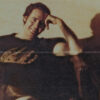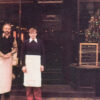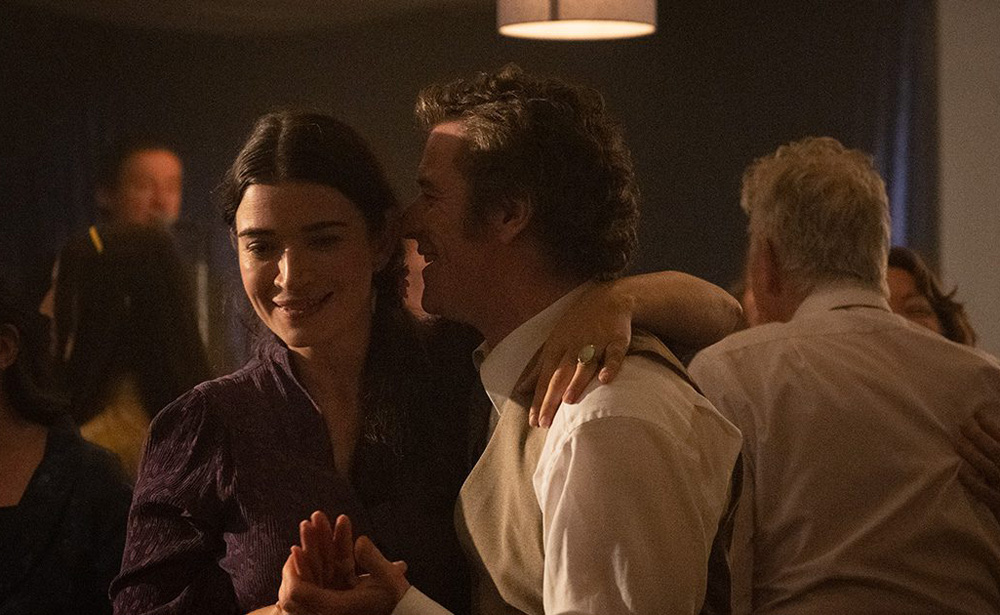The Ruttledge home in the far reaches of Ireland on the River Shannon has become a destination in “That They May Face the Rising Sun,” an adaptation of beloved author John McGahern’s final novel about a couple that has moved to the country for a simpler life after years in London but find it complicated by having fewer other neighbors around where each relationship is all the more intense. Joe (Barry Ward), a writer, and Katie (Anna Bederke), an artist in her own right with a pen or a sewing needle depending on the day, leave their door open to all visitors who are generally a decade or two older they they are and could use a compassionate ear or someone to break bread with when company is hard to come by. However, they have their own restlessness as Katie has to wonder whether they made the right decision to leave the city when passing the time can prove difficult even amidst such idyllic surroundings and the two are left with little option but to engage with everyone that comes their way, even the taciturn Patrick (Lalor Roddy) whose discontent seems immutable.
Pat Collins, who previously observed the beauty that can grow out of a small community in his lovely 2017 drama “Song of Granite,” had long admired McGahern’s gentle approach to storytelling in which the rhythms of life propelled the narrative rather than any overt plotting and after profiling the writer for the 2005 doc “John McGahern: A Private World,” he does proper tribute to his work once again in reviving that same spirit for “That They May Face the Rising Sun.” Covering a year in the lives of the Ruttledges, the film shows the couple untouched by any major incidents yet their perception of the world is constantly reshaped on a daily basis by the people and changing conditions around them that’s influence is largely imperceptible in the moment but immeasurable across time. Weddings and funerals provide certain milestones, but people find out what they’re really living for when sitting around a table from one another and make meaning for each other and as occasionally awkward and uncomfortable a process as that can be, Collins finds the grace in it when there’s an understanding.
After becoming a local sensation that culminated in winning the Irish Film and Television Awards last year, “That They My Face the Rising Sun” is beginning to roll out around the world, making its way to America this week and Collins graciously took the time to talk about how he fashioned a shoot that could bring McGahern’s delicate sensibilities to the screen, appreciating his place as merely the first audience to take in the drama unfolding in front of him on set and discovering that he was covering far more ground than he could imagine in settling into a small Irish village.
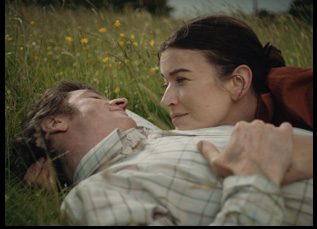
Yeah, this was my favorite of his novels and the one that I felt like it’s something that I could make a film of, maybe because of the pace of it and [how it was] set over a year and the changing seasons. The slow pace of it appealed to me, but I didn’t feel like I could have done it 20 years ago when I was so young. I was a slow starter, but I I started thinking of it maybe for the last 12 years and John died in 2006, but I approached his widow Madeline and asked her what she thought of the idea. She gave me great encouragement and we took it from there, writing the script from 2016 until 2023 when we when we actually shot it.
This seems like such a wily narrative to adapt when so much of the story, whether it’s the backstory of the Ruttleges in London or the history of the other characters, lives in the imagination. What helped you crack it?
It was a question of being true to the characters that are in the novel, which were all well-written, and try to bring that to the screen. The big job there is casting and if you don’t get the casting right in a film like this, you’re finished. It’s a very thin line [because] the kitchen was almost like a stage where people came onto the stage and did a little performance and left again and then somebody else came in, so you’re playing around with theatricality but it’s very easy to tip that over into something that’s too theatrical and too stagey.
The film also wouldn’t work without the shots of nature and the slow pace. I think where we could have really gone wrong is try to put too much story into it, so I was able to make all the stories little small stories that are continuously unfolding. If I was being pushed to make it more dramatic or everything had to serve the story, the film would have fallen apart. I was determined from the very beginning that we weren’t going to be a slave to the story or the locations and the weather. The changing seasons had to be as as important as the stories that were unfolding.

We did shoot mostly in spring and early summer and then went back in December and shot again for the winter. One of the best things was being able to go back, so you could see the cold and the breath and there was snow on the mountains. You can’t really get it authentically done unless you actually do shoot over a prolonged period. But it’s one of the wettest parts of the country. There’s more rain in that valley than there is in most other parts and that’s why it looks so green because there’s os much rainfall, it’s very fertile. It made the hay scene quite difficult. We were lucky to get that done, but we got a few nice days when we needed them.
Were you actually familiar with the location ahead of time?
John McGahern, the writer of the novel, was from Leitrim and the book was based around the lake that was in front of his house where he lived. But we spent months looking for that location and others and we couldn’t find it because there was so many houses had been modernized. The film is set in 1979/1980 so it was very difficult to find any places that weren’t touched by the modern life. We eventually had to go to the Galway-Mayo border where we shot and that was very much off the beaten track. A lot of the film crew had never been there before and Ireland is a small country, but there’s lots of little roads going up different valleys and most people hadn’t been there, so it’s maybe the first time that valley has been seen on a big feature film. It’s been done in documentaries before but not [a narrative].
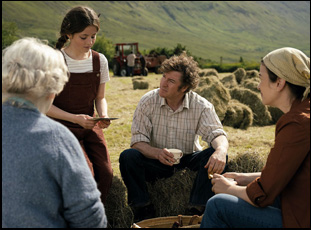
If you get four people in a room and the scene is 10 minutes, you can play that scene in the edit in thousands of ways. There’s thousands of variations and it was about eight months editing, so we tried a lot of them. And one of the themes of the film is how we listen to people and if we give people scope and space, even if you don’t agree with them, you try to find accommodation and that’s precisely the kind of stuff that we need in the world right now. You might not get on with your neighbor or you might not have the same views, but everybody needs each other and it’s much better world if you actually don’t fall out over your differences. You actually try to find a common ground even if you disagree with them. [These characters are] attentive to each other even though, say, Patrick is kind of cruel to Joe and to Kate sometimes and Joe still goes over with a bottle of whiskey at Christmas day.
So strangely, all of those things where Joe and Kate are listening are paying attention and maybe offering advice but sometimes stepping back and not saying something — when do you remain silent, when do you speak, all of those codes and manners — really [influenced us] in the edit as well as why we went with so many shots where Joe is listening and nods or pays attention to somebody or everybody looks at each other.
Once you get this in the hands of the actors, was there anything you may not have expected but could get excited about once you saw the dynamics between them?
What was exciting for me coming from a documentary background was the sheer experience and intelligence of all of the actors. You really had to listen to them because they had great insights into their characters and great suggestions for taking scenes further or pulling back a little bit. I’d like to think that I’m always open to listening to what the actors have to say and I’m not always right. The actors aren’t always right, either, but if you listen to each other we’d find the right way to get along. Sometimes maybe even when you’re writing a script you don’t fully get [a scene], but when it happens in the flow of the film it becomes much more powerful than what you think is possible even in the script stage because the character is there on the screen in front of you. That’s true even for the director because it’s true for the audience and it should be like that because that’s the I’m part of the audience as well to a certain extent. You’re watching the actors work and sometimes you’re moved in a way that you don’t you didn’t necessarily anticipate and that’s that’s when you know it’s something really good is happening.
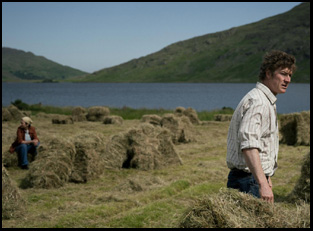
It wasn’t in the script, and he was a writer in the script, but it might be just a scene where Joe is writing in his room, looking out the window. But I always had it in the back of my mind that there were certain passages from the book that I thought I’d love to include and wasn’t sure how to in the script stage. Then it just seemed natural when we were filming that we got [Barry Ward] to record those scenes where he’s going back over the work and some of the most beautiful passages from the novel are the ones that were included in the film. I think they do bring a richness to it and an elegiac element to it. It was very true to my experience of John McGahern, making the documentary and thinking about the novel and how some of what we were seeing on screen was written by the character of Joe or that it was a reaction from what we had seen.
What’s it been like getting it out into the world?
It’s great. It had a fantastic reaction in Ireland and I hadn’t experienced that kind of reaction before to any work that I’d made, even when it was on Irish television. It’s a nice feeling when people do respond well to it — I don’t I do the work for myself. I do the work hoping that it connects with people, but when it actually connects with a lot of people it’s a lovely feeling and I might never I might never get that reaction again, so you have to enjoy it while it happens. It also screened in Santa Barbara and I was walking around, thinking “Oh God, how are people in Santa Barbara going to connect with this these characters in rural Ireland?” But it actually worked at the festival there, and the same thing happened in Sweden [where] people came up and said “This is exactly like people who live in rural Sweden,” so I think there’s something very universal about it and I’m delighted with that.
“That They May Face the Rising Sun” opens on April 11th in New York at the Quad Cinema, Los Angeles at the Laemmle Royal, Dedham, MA at the Dedham Community Theatre and in Atlanta at the Tara Theatre Atlanta. A full schedule of theaters and dates is here.

